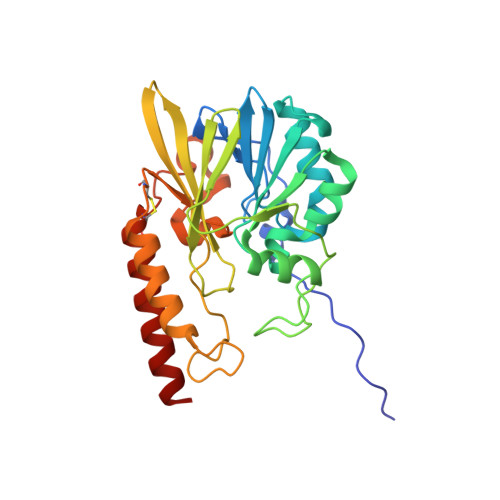2-Mercaptomethyl Thiazolidines (MMTZs) Inhibit All Metallo-beta-Lactamase Classes by Maintaining a Conserved Binding Mode.
Hinchliffe, P., Moreno, D.M., Rossi, M.A., Mojica, M.F., Martinez, V., Villamil, V., Spellberg, B., Drusano, G.L., Banchio, C., Mahler, G., Bonomo, R.A., Vila, A.J., Spencer, J.(2021) ACS Infect Dis 7: 2697-2706
- PubMed: 34355567
- DOI: https://doi.org/10.1021/acsinfecdis.1c00194
- Primary Citation of Related Structures:
7BJ8, 7BJ9 - PubMed Abstract:
Metallo-β-lactamase (MBL) production in Gram-negative bacteria is an important contributor to β-lactam antibiotic resistance. Combining β-lactams with β-lactamase inhibitors (BLIs) is a validated route to overcoming resistance, but MBL inhibitors are not available in the clinic. On the basis of zinc utilization and sequence, MBLs are divided into three subclasses, B1, B2, and B3, whose differing active-site architectures hinder development of BLIs capable of "cross-class" MBL inhibition. We previously described 2-mercaptomethyl thiazolidines (MMTZs) as B1 MBL inhibitors (e.g., NDM-1) and here show that inhibition extends to the clinically relevant B2 (Sfh-I) and B3 (L1) enzymes. MMTZs inhibit purified MBLs in vitro (e.g., Sfh-I, K i 0.16 μM) and potentiate β-lactam activity against producer strains. X-ray crystallography reveals that inhibition involves direct interaction of the MMTZ thiol with the mono- or dizinc centers of Sfh-I/L1, respectively. This is further enhanced by sulfur-π interactions with a conserved active site tryptophan. Computational studies reveal that the stereochemistry at chiral centers is critical, showing less potent MMTZ stereoisomers (up to 800-fold) as unable to replicate sulfur-π interactions in Sfh-I, largely through steric constraints in a compact active site. Furthermore, in silico replacement of the thiazolidine sulfur with oxygen (forming an oxazolidine) resulted in less favorable aromatic interactions with B2 MBLs, though the effect is less than that previously observed for the subclass B1 enzyme NDM-1. In the B3 enzyme L1, these effects are offset by additional MMTZ interactions with the protein main chain. MMTZs can therefore inhibit all MBL classes by maintaining conserved binding modes through different routes.
- School of Cellular and Molecular Medicine, University of Bristol, Biomedical Sciences Building, University Walk, Bristol BS8 1TD, U.K.
Organizational Affiliation:



















